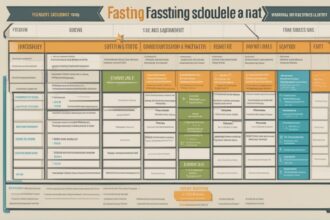Hey there, health enthusiasts! If you’ve been curious about fasting and how it can transform your wellness journey, you’ve landed in the right place. Fasting isn’t just a trend—it’s a powerful tool backed by science to improve metabolism, mental clarity, and even longevity. But here’s the thing: success with fasting hinges on finding the right fasting schedule that fits your lifestyle. In this ultimate guide, we’re diving deep into fasting schedules, sharing actionable fasting tips, and breaking down the science to help you fast smarter, not harder. Whether you’re a newbie or a seasoned faster, let’s explore how to make intermittent fasting work for you!
What Are Fasting Schedules and Why Do They Matter?
Fasting schedules are structured plans that dictate when you eat and when you abstain from food. They’re the backbone of intermittent fasting (IF), a practice where you cycle between periods of eating and fasting. Why does this matter? Well, fasting isn’t just about skipping meals—it’s about giving your body a break from digestion to trigger processes like autophagy, where cells clean out damaged components (Levine & Kroemer, 2019). The right schedule can help you burn fat, stabilize blood sugar, and reduce inflammation, but picking the wrong one can leave you hungry, irritable, and ready to quit. So, let’s unpack the most popular fasting schedules and find the one that aligns with your goals using practical fasting advice.
Popular Fasting Schedules to Kickstart Your Journey
Not all fasting schedules are created equal, and what works for your friend might not work for you. Below, I’ve outlined some of the most popular methods to give you a starting point. Each comes with its own benefits and challenges, so consider your daily routine and health goals as you choose. These are great entry points if you’re looking for fasting strategies to experiment with.
- 16/8 Method: Fast for 16 hours and eat during an 8-hour window. For example, eat between noon and 8 PM. It’s beginner-friendly and aligns with most schedules.
- 5:2 Diet: Eat normally for 5 days of the week, then restrict calories to 500–600 on 2 non-consecutive days. It’s flexible but requires discipline on fasting days.
- Eat-Stop-Eat: Involves a full 24-hour fast once or twice a week. It’s more intense but can yield significant results for weight loss (Tinsley & La Bounty, 2015).
- Alternate-Day Fasting: Alternate between normal eating days and fasting days (or very low-calorie intake). It’s effective but can be tough to sustain.
Science Behind Fasting: How It Benefits Your Body
Let’s get into the nitty-gritty—why does fasting work? When you fast, your body switches from using glucose as its primary fuel to burning stored fat through a process called ketosis. This metabolic shift doesn’t just help with weight loss; it also improves insulin sensitivity, which is crucial for preventing type 2 diabetes (Anton et al., 2018). Fasting also reduces markers of inflammation, a root cause of many chronic diseases (Faris et al., 2012). Plus, studies suggest that fasting can boost brain health by increasing levels of brain-derived neurotrophic factor (BDNF), a protein linked to learning and memory (Mattson et al., 2017). These benefits are why so many people turn to fasting for health, but timing and consistency—key fasting tips—are what make or break your results.
How to Choose the Right Fasting Schedule for You
With so many fasting plans out there, picking the right one can feel overwhelming. The trick is to match your schedule to your lifestyle, energy needs, and personal goals. Are you someone who can skip breakfast without a second thought, or do you need a morning meal to function? Do you have a packed social calendar that makes weekend fasting tough? Asking yourself these questions is a critical piece of fasting guidance. Start with a less intense method like 16/8 if you’re new, and don’t be afraid to tweak it. Remember, fasting should feel sustainable, not like a punishment. Also, consult a healthcare provider if you have medical conditions like diabetes or are pregnant—safety first (Johnstone, 2015).
Practical Fasting Tips to Stay on Track
Alright, you’ve chosen a fasting schedule—now how do you stick to it without caving at the first sight of a donut? I’ve been there, and trust me, a little preparation goes a long way. Fasting isn’t just about willpower; it’s about setting yourself up for success with smart fasting techniques. Here are some tried-and-true strategies that have helped me and countless others stay the course, even on tough days.
- Stay Hydrated: Drink plenty of water during fasting windows to curb hunger and support detoxification. Herbal teas and black coffee (no sugar!) are also great options.
- Plan Your Meals: Prep nutrient-dense meals for your eating windows to avoid overeating junk food. Focus on protein, healthy fats, and fiber to stay full longer.
- Start Slow: If 16/8 feels daunting, begin with 12/12 (12 hours fasting, 12 hours eating) and gradually increase your fasting window.
- Manage Cravings: Distract yourself with light activity or chew sugar-free gum. Cravings often pass within 10–15 minutes if you ride them out.
- Track Progress: Use a journal or app to log how you feel during fasting. Noting energy levels and mood can help you adjust your approach.
Common Pitfalls and How to Avoid Them
Let’s be real—fasting isn’t always smooth sailing. Even with the best fasting recommendations, you might hit some bumps along the way. One common mistake is overeating during eating windows, which can negate the calorie deficit fasting creates. Another is pushing too hard, too fast—jumping into a 24-hour fast without building up to it can leave you exhausted and frustrated. Then there’s the social aspect; dining out or family meals can throw off your schedule if you’re not prepared. The fix? Communicate your goals with loved ones, plan cheat meals strategically, and listen to your body. If you’re feeling dizzy or weak, break your fast—there’s no shame in prioritizing health (Rynders et al., 2019). These fasting tips can help you dodge the most common traps and keep moving forward.
So, there you have it—a comprehensive roadmap to mastering fasting schedules and making intermittent fasting a sustainable part of your life. Remember, fasting isn’t a one-size-fits-all deal; it’s about experimenting with different schedules and incorporating fasting tips that resonate with you. Start small, stay consistent, and celebrate the little wins—whether it’s more energy, clearer skin, or shedding a few pounds. Your body will thank you for the break, and with time, fasting can become second nature. Got questions or personal fasting stories to share? Drop them in the comments—I’d love to hear how you’re making fasting work for you!
References
- Anton, S. D., Moehl, K., Donahoo, W. T., Marosi, K., Lee, S. A., Mainous, A. G., … & Mattson, M. P. (2018). Flipping the metabolic switch: Understanding and applying the health benefits of fasting. Obesity, 26(2), 254-268.
- Faris, M. A., Kacimi, S., Al-Kurd, R. A., Fararjeh, M. A., Bustanji, Y. K., Mohammad, M. K., & Salem, M. L. (2012). Intermittent fasting during Ramadan attenuates proinflammatory cytokines and immune cells in healthy subjects. Nutrition Research, 32(12), 947-955.
- Johnstone, A. (2015). Fasting for weight loss: An effective strategy or latest dieting trend? International Journal of Obesity, 39(5), 727-733.
- Levine, B., & Kroemer, G. (2019). Biological functions of autophagy genes: A disease perspective. Cell, 176(1-2), 11-42.
- Mattson, M. P., Longo, V. D., & Harvie, M. (2017). Impact of intermittent fasting on health and disease processes. Ageing Research Reviews, 39, 46-58.
- Rynders, C. A., Thomas, E. A., Zaman, A., Pan, Z., Catenacci, V. A., & Melanson, E. L. (2019). Effectiveness of intermittent fasting and time-restricted feeding compared to continuous energy restriction for weight loss. Nutrients, 11(10), 2442.






